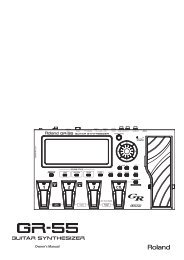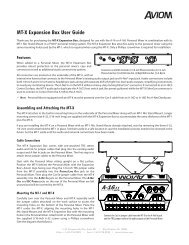Cubix User Manual Rev. 01a - CHAUVET® Lighting
Cubix User Manual Rev. 01a - CHAUVET® Lighting
Cubix User Manual Rev. 01a - CHAUVET® Lighting
You also want an ePaper? Increase the reach of your titles
YUMPU automatically turns print PDFs into web optimized ePapers that Google loves.
DMX Cabling<br />
DMX Connectors<br />
The DMX protocol requires using special data cables to accommodate for the high<br />
speed digital signals it uses. Despite their apparent similarities, data cables are<br />
electrically different from standard microphone cables because they can carry high<br />
frequency digital signals and have better protection against electromagnetic<br />
interference. You can purchase <strong>CHAUVET®</strong> certified DMX cables directly from a<br />
dealer/distributor or make your own DMX cable.<br />
If you choose to make your own DMX cable, you must use a data-grade cable such<br />
as the Belden 9841, which has the following electrical characteristics:<br />
Type:<br />
Maximum capacitance between conductors:<br />
Maximum capacitance between conductor and shield:<br />
Maximum resistance:<br />
Nominal impedance:<br />
shielded, 2-conductor twisted pair<br />
30 pF/ft<br />
55 pF/ft<br />
20 ohms/1000 ft<br />
100~140 ohms<br />
Each DMX cable must have a male XLR connector on one end and a female XLR<br />
connector on the other end. The DMX protocol indicates that the XLR connectors<br />
must have five pins. However, most lighting fixtures use the 3-pin XLR connector.<br />
The pin assignment of the 3-pin and 5-pin XLR connectors in a DMX cable is as<br />
follows:<br />
Male Plug<br />
Female Plug<br />
Signal 3-Pin 5-Pin 5-Pin 3-Pin Signal<br />
Common 1 1 1 1 Common<br />
Data - 2 2 2 2 Data -<br />
Data + 3 3 3 3 Data +<br />
Not used 4 4 Not used<br />
Not used 5 5 Not used<br />
You can use the above table to create a 3-pin/3-pin cable, a 5-pin/5-pin cable, or a 3-<br />
pin to 5-pin adapter.<br />
The DMX daisy chain uses a terminator to reduce signal transmission problems,<br />
especially with long cables. The terminator consists of either a 3-pin or 5-pin XLR<br />
male plug with a 120 Ω, ¼ W resistor connected to the wire side of pins 2 and 3, as<br />
shown below.<br />
The terminator plug connects to the DMX Out socket of the last DMX fixture in the<br />
daisy chain.<br />
Do not allow the common wire of the DMX cable to touch the fixture’s chassis<br />
ground. This could cause a ground loop, which may affect your fixtures’<br />
performance. Test all DMX cables with an ohmmeter to verify the correct<br />
polarity of the wires, and to make sure that they are not touching the shield or<br />
each other.<br />
Page 16 of 18 <strong>Cubix</strong> <strong>User</strong> <strong>Manual</strong> (<strong>Rev</strong>. <strong>01a</strong>)
















